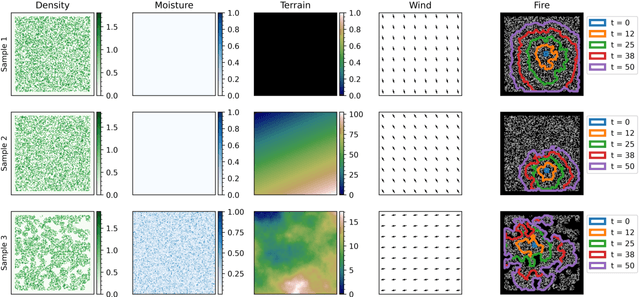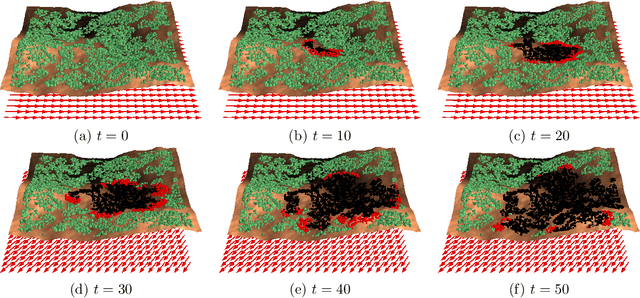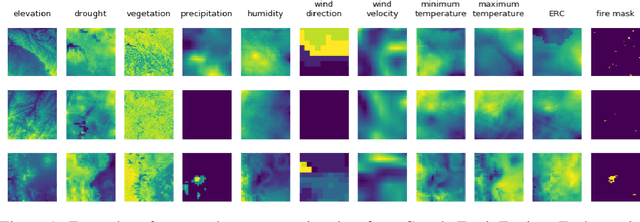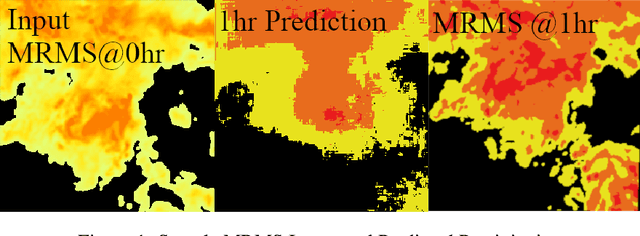John Burge
Recurrent Convolutional Deep Neural Networks for Modeling Time-Resolved Wildfire Spread Behavior
Oct 28, 2022Abstract:The increasing incidence and severity of wildfires underscores the necessity of accurately predicting their behavior. While high-fidelity models derived from first principles offer physical accuracy, they are too computationally expensive for use in real-time fire response. Low-fidelity models sacrifice some physical accuracy and generalizability via the integration of empirical measurements, but enable real-time simulations for operational use in fire response. Machine learning techniques offer the ability to bridge these objectives by learning first-principles physics while achieving computational speedup. While deep learning approaches have demonstrated the ability to predict wildfire propagation over large time periods, time-resolved fire-spread predictions are needed for active fire management. In this work, we evaluate the ability of deep learning approaches in accurately modeling the time-resolved dynamics of wildfires. We use an autoregressive process in which a convolutional recurrent deep learning model makes predictions that propagate a wildfire over 15 minute increments. We demonstrate the model in application to three simulated datasets of increasing complexity, containing both field fires with homogeneous fuel distribution as well as real-world topologies sampled from the California region of the United States. We show that even after 100 autoregressive predictions representing more than 24 hours of simulated fire spread, the resulting models generate stable and realistic propagation dynamics, achieving a Jaccard score between 0.89 and 0.94 when predicting the resulting fire scar.
Convolutional LSTM Neural Networks for Modeling Wildland Fire Dynamics
Dec 11, 2020



Abstract:As the climate changes, the severity of wildland fires is expected to worsen. Understanding, controlling and mitigating these fires requires building models to accurately capture the fire-propagation dynamics. Supervised machine learning techniques provide a potential approach for developing such models. The objective of this study is to evaluate the feasibility of using the Convolutional Long Short-Term Memory (ConvLSTM) recurrent neural network (RNN) to model the dynamics of wildland fire propagation. The model is trained on simulated wildfire data generated by a cellular automaton percolation model. Four simulated datasets are analyzed, each with increasing degrees of complexity. The simplest dataset includes a constant wind direction as a single confounding factor, whereas the most complex dataset includes dynamic wind, complex terrain, spatially varying moisture content and realistic vegetation density distributions. We examine how effectively the ConvLSTM can capture the fire-spread dynamics over consecutive time steps using classification and regression metrics. It is shown that these ConvLSTMs are capable of capturing local fire transmission events, as well as the overall fire dynamics, such as the rate at which the fire spreads. Finally, we demonstrate that ConvLSTMs outperform non-temporal Convolutional Neural Networks(CNNs), particularly on the most difficult dataset.
Deep Learning Models for Predicting Wildfires from Historical Remote-Sensing Data
Oct 15, 2020



Abstract:Identifying regions that have high likelihood for wildfires is a key component of land and forestry management and disaster preparedness. We create a data set by aggregating nearly a decade of remote-sensing data and historical fire records to predict wildfires. This prediction problem is framed as three machine learning tasks. Results are compared and analyzed for four different deep learning models to estimate wildfire likelihood. The results demonstrate that deep learning models can successfully identify areas of high fire likelihood using aggregated data about vegetation, weather, and topography with an AUC of 83%.
Machine Learning for Precipitation Nowcasting from Radar Images
Dec 11, 2019

Abstract:High-resolution nowcasting is an essential tool needed for effective adaptation to climate change, particularly for extreme weather. As Deep Learning (DL) techniques have shown dramatic promise in many domains, including the geosciences, we present an application of DL to the problem of precipitation nowcasting, i.e., high-resolution (1 km x 1 km) short-term (1 hour) predictions of precipitation. We treat forecasting as an image-to-image translation problem and leverage the power of the ubiquitous UNET convolutional neural network. We find this performs favorably when compared to three commonly used models: optical flow, persistence and NOAA's numerical one-hour HRRR nowcasting prediction.
 Add to Chrome
Add to Chrome Add to Firefox
Add to Firefox Add to Edge
Add to Edge